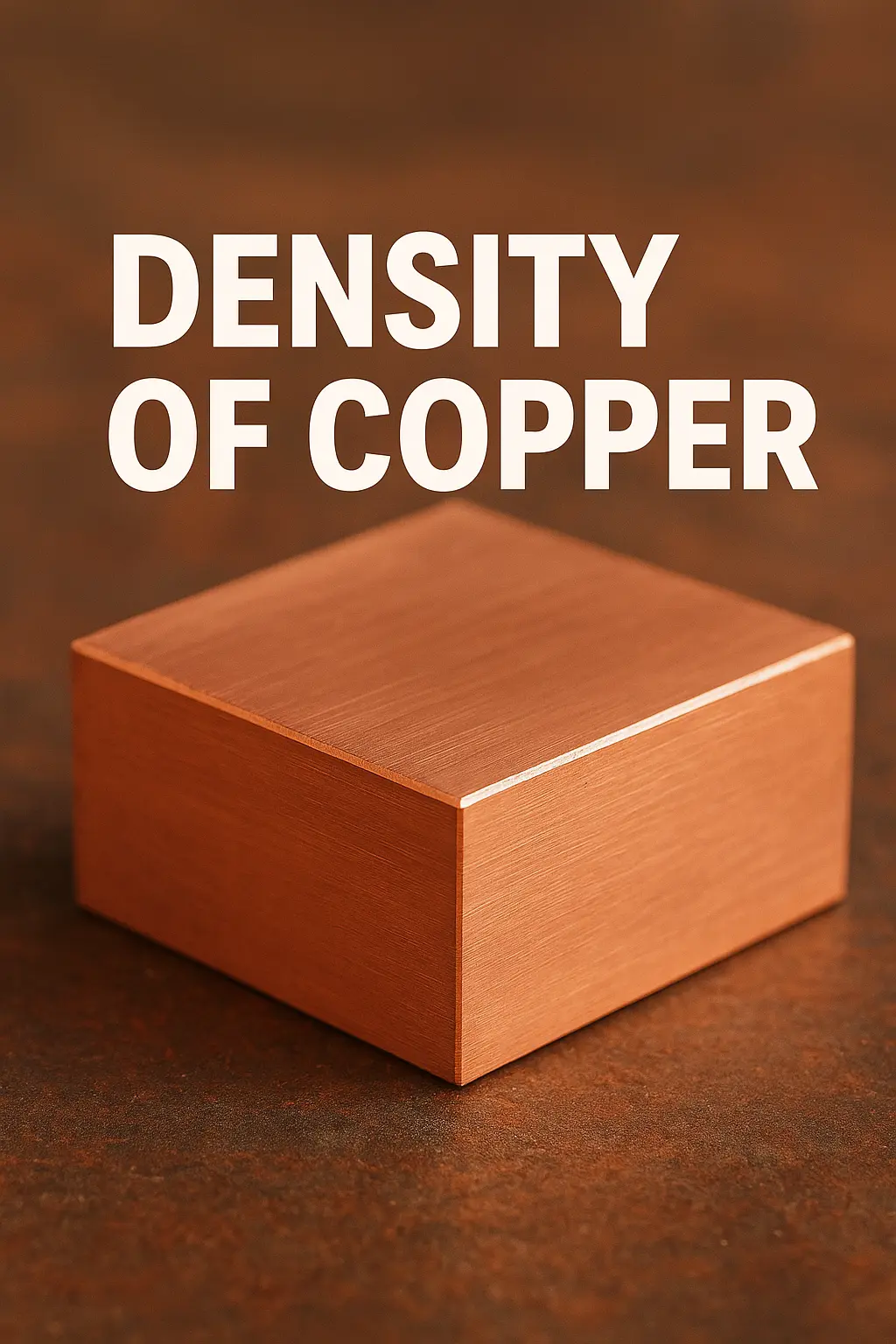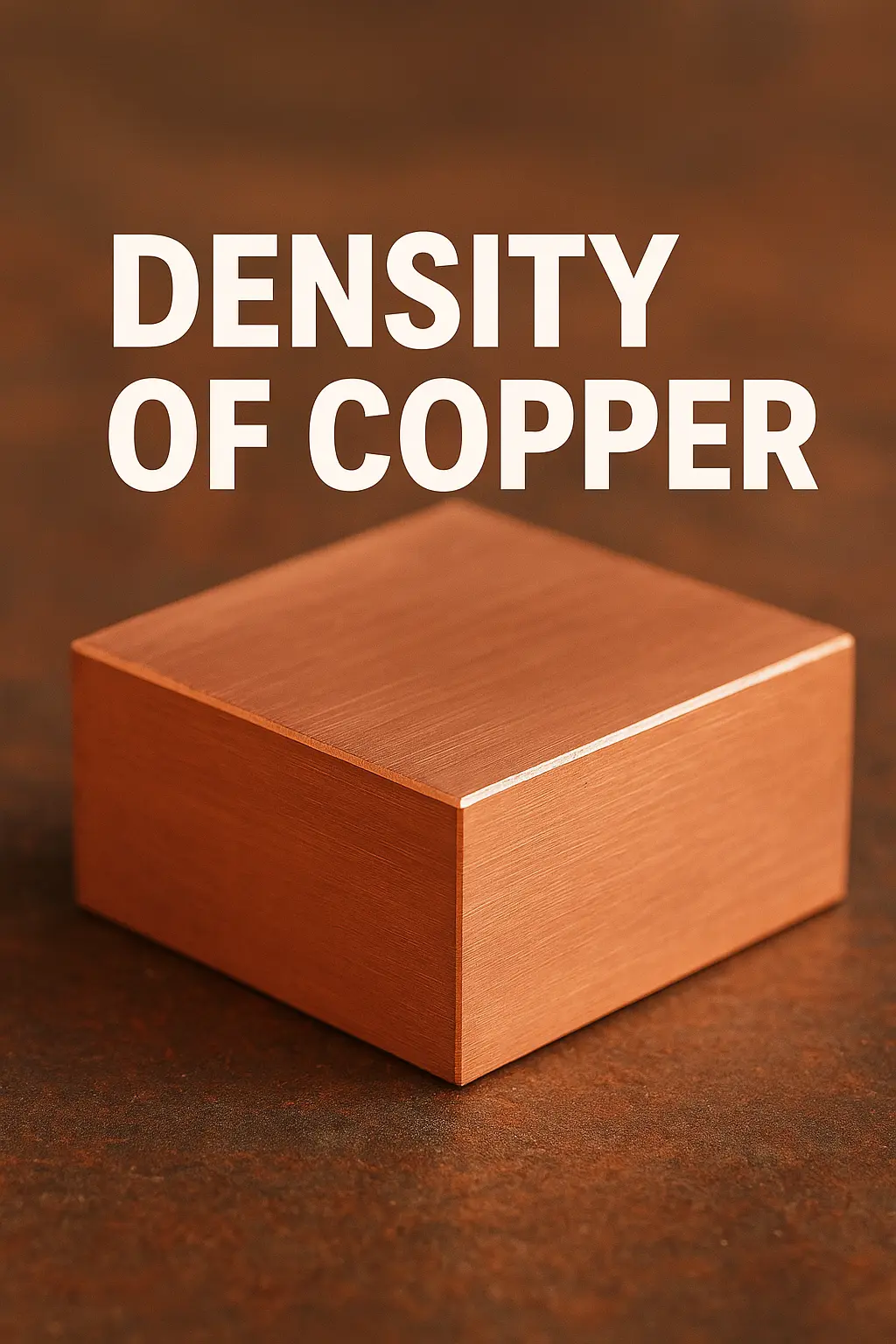In this article, we will evaluate critical aspects about the density of copper, a fundamental property that plays a crucial role in precision sheet metal fabrication and various engineering applications. Understanding the density of copper in kg/m3 is essential for engineers and manufacturing designers working with this versatile metal.
From discussing the exact value, density of copper alloys to factors affecting the copper density, you will find comprehensive information that will help you make informed decisions in your sheet metal fabrication services and design processes. Whether you're calculating material requirements or optimizing manufacturing processes, knowing what is the density of copper metal is crucial.
Let's dive right in.
What is the Real Density of Copper?

The real density of copper is 8.96 g/cm³ (equivalent to 8,960 kg/m3). Due to this high density, copper is widely used in areas that call for toughness coupled with good conductivity of heat and electricity. In precision sheet metal fabrication, understanding the number density of copper is crucial for accurate material calculations and design specifications. Besides, the density can also be used to gauge the purity of copper, which will be important when it comes to the manufacturing process, especially in applications requiring high-precision components.
Factors Affecting Density of Copper
Purity
The actual density of copper which lies at 8.96 g/cm³ depends on its purity. The density also reduces when other elements or impurities are added in the mixture and in a given substance. This is particularly important in sheet metal fabrication processes where material properties directly impact the final product quality.
For instance, if you are using copper alloys such as brass that have mixtures of zinc, then the density is going to be lower than that of pure copper. These applications require full conductivity and strength of the copper, hence the need to have high purity. In precision engineering applications, even slight variations in density can affect the performance and reliability of the final product.
Alloying Elements
One thing you might notice is that the density of copper varies depending on the type of metals it is combined with to make an alloy. Alloying also affects the strength and ductility of copper, which is why density should be taken into consideration when choosing materials for sheet metal fabrication services. The relationship between alloying elements and density is particularly crucial in applications where weight considerations are paramount, such as aerospace components or mobile equipment.
Temperature
In high temperatures, like in smelting and electrical equipment, you will find slightly less density of copper atoms than in a solid state. On the other hand, applying heat to copper material reduces its density, while cooling makes it gain density. You need to consider this thermal expansion and contraction when estimating the quantity of material needed at high temperatures. This is especially important in precision sheet metal fabrication processes where thermal considerations can significantly impact the final dimensions and properties of the component.
Density of Copper Alloys
Brass (Copper-Zinc Alloy)
The density of brass is normally in the region of 8.4 to 8.7 g/cm³. It is often used in situations where corrosion and malleability of the material are important, such as in plumbing or in the making of musical instruments. In sheet metal fabrication, brass is particularly valued for its excellent formability and aesthetic appeal, making it a popular choice for architectural applications and decorative elements.
ALSO READ:Understanding Brass Density
Bronze (Copper-Tin Alloy)
Bronze has a density varying between 7.4 and 8.8 g/cm³, which largely depends on the content of tin. Bronze is used more often in bearings, bushings, and sculptures for artwork since it offers strong wear and tear. In precision sheet metal fabrication, bronze's density characteristics make it ideal for applications requiring both strength and corrosion resistance, such as marine hardware and industrial equipment components.
Cupronickel (Copper-Nickel Alloy)
Cupronickel, which has a density of about 8.9 g/cm³, has exceptional corrosion resistance, particularly in marine areas. This makes it suitable for use in shipbuilding, the manufacturing of coins, as well as the fabrication of pipes. In sheet metal fabrication services, cupronickel is often selected for applications where exposure to harsh environmental conditions is expected, such as offshore equipment and chemical processing facilities.
Comparing Density of Copper to Common Metals
Now let's compare the copper density to other metals. Understanding these density relationships is crucial for engineers and designers working in sheet metal fabrication, as it helps in material selection and design optimization. The density of copper in kg/m3 (8,960) serves as a useful reference point when comparing with other metals commonly used in manufacturing and fabrication processes.
Copper has a significantly higher density than several commonly used metals in sheet metal fabrication, including aluminum (2,700 kg/m³), zinc (7,140 kg/m³), and steel (7,850 kg/m³). However, it maintains a lower density compared to precious metals like silver (10,490 kg/m³), gold (19,320 kg/m³), and lead (11,340 kg/m³). This unique positioning in the density spectrum makes copper particularly valuable in precision sheet metal fabrication applications where a balance of weight and performance is crucial.
When selecting materials for your sheet metal fabrication services, understanding these density variations becomes instrumental in achieving the optimal combination of weight, strength, and conductivity. The density of copper metal, being relatively higher compared to many industrial metals, contributes to its enhanced durability and superior conduction characteristics. This makes it an excellent choice for applications requiring both structural integrity and efficient heat or electrical conductivity.
Calculating Density of Copper
To accurately determine the density of copper in kg/m3 for your precision sheet metal fabrication projects, follow these comprehensive steps:
- Mass: The mass of copper can be determined using a calibrated balance or precision scale. For sheet metal fabrication applications, it's crucial to ensure the measuring equipment is properly calibrated to maintain accuracy in material calculations.
- Volume: There are multiple methods to compute the volume of copper, depending on the shape and form of the material:
- Regular Shapes: For simple geometric shapes commonly used in sheet metal fabrication services, such as cubes, spheres, or rectangular sheets, standard mathematical formulas can be applied. For instance:
- For rectangular sheets: length × width × thickness
- For cylindrical forms: π × radius² × height
- For cubic forms: length × width × height
- Irregular Shapes: When working with complex or irregular shapes in precision sheet metal fabrication, displacement techniques offer accurate volume measurements. This involves:
- Immersing the copper piece in a graduated cylinder
- Recording the initial and final water levels
- Calculating the difference to determine the volume
- Converting the measurements to appropriate units for density calculation
FAQ
1. What is the Density of Scrap Copper?
The density of scrap copper fundamentally matches that of pure copper, maintaining approximately 8 g/cc (8,960 kg/m³). However, several factors in sheet metal fabrication can influence the apparent density:
- Surface oxidation from environmental exposure
- Presence of contaminants or coating materials
- Alloying elements from previous manufacturing processes
- Structural defects or voids in the material
When working with scrap copper in sheet metal fabrication projects, it's essential to consider these potential variations. While the theoretical density remains constant, practical applications may require accounting for these impurities and structural irregularities. This becomes particularly important in precision sheet metal fabrication where material properties directly impact product quality.
Conclusion
Understanding the density of copper metal is crucial for engineers and designers working in sheet metal fabrication. While copper exhibits a relatively higher density compared to many common industrial metals, this characteristic contributes to its versatility in various applications. The density of copper in kg/m3 serves as a fundamental parameter in material selection and design calculations.
The actual density may vary depending on several factors:
- Degree of material purity
- Alloy composition and additives
- Manufacturing processes and conditions
- Environmental factors and storage conditions
Armed with this comprehensive knowledge about what is the density of copper and its variations, professionals can make informed decisions in:
- Material selection for specific applications
- Cost-effective resource utilization
- Quality control processes
- Design optimization for weight-critical applications
This understanding enables engineers and designers to optimize their sheet metal fabrication processes and achieve superior results in their manufacturing projects.
More resources:
Density of Galvanized Steel
Real Density of Copper
Tungsten Density Explained
What is the Density Of Lead
What Is the Average Density of Brass
Advanced Materials in Sheet Metal Fabrication
How to Choose Metal Fabricators in China
















